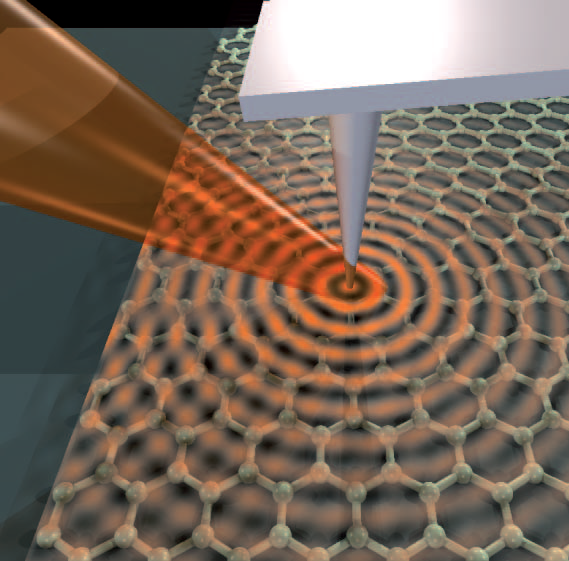It’s been only a week ago that I wrote about the increasing competition for graphene. But as I said then, there are still some exciting advances based on graphene. An example is photonics, which is an area where traditionally graphene perhaps has not been as strong as in electronics. A reason for this is that being only a single atomic layer thin, graphene initially wasn’t expected to show much interaction with light. One of the more intriguing historic results in this area has been the fact that the absorption of light in graphene is determined by one of nature’s most fundamental numbers, the fine structure constant.

Plasmons in graphene can be created by illuminating the tip of an atomic force microscope (grey) with an infrared laser beam (red). Reprinted by permission from Macmillan Publishers Ltd. Fei Z. et al. Nature 487, 82–85 (2012). doi:10.1038/nature11253
But absorption of light is not where the true potential of graphene lies, namely on the nanoscale. On the same scale as electronic applications, because ultimately the aim is to achieve photonic functionality on a chip.
However, the control of light on the nanoscale typically requires surface plasmons. These are collective movements of electrons at the surface of metals. So in a sense surface plasmons function a bit like antenna that can focus light into tiny spots.
Graphene itself is not a metal, or at least not in the same way as the noble metals gold or silver that are usually used for plasmonic applications. Still, graphene’s electrical conductivity is not too bad and its electrons can move pretty fast. For this reason, graphene does also show plasmonic effects. This is good news, because in comparison to gold or silver, graphene has a significant advantage: its plasmonic properties can be easily influenced by external means such as an electrical voltage, which either adds or removes the free electrical charges needed for plasmonics.
Already, good plasmonic properties have been demonstrated in graphene, with plasmon propagation distances of several micrometers (see figure). This suggests that graphene could in principle be useful in guiding light on a chip. To me, however, the potential of graphene is not necessarily that it can transmit light. The promise lies perhaps more in the fact that plasmonic effects can be controlled. And all this based on a single atomic layer only.
For example, it is well known that graphene’s electrical properties are quite sensitive to its environment. Whether it is an applied electric voltage or other factors such as molecules that are bound to graphene’s surface and that change the electronic properties this way. Combined with a strong sensitivity of plasmonic effects this would make for very efficient detectors.
And then of course there are all the ongoing attempts that make use of graphene’s electronic properties. Optical devices could benefit a lot from coupling such electronic effects with optical ones. The recent demonstration of electrical switching of terahertz radiation using graphene devices is just a first step amongst a number of very promising strategies investigated, many of which have been reviewed nicely in this month’s issue of Nature Photonics. So watch out for new plasmonic applications using graphene.
References:
Nair, R., Blake, P., Grigorenko, A., Novoselov, K., Booth, T., Stauber, T., Peres, N., & Geim, A. (2008). Fine Structure Constant Defines Visual Transparency of Graphene Science, 320 (5881), 1308-1308 DOI: 10.1126/science.1156965
Fei, Z., Rodin, A., Andreev, G., Bao, W., McLeod, A., Wagner, M., Zhang, L., Zhao, Z., Thiemens, M., Dominguez, G., Fogler, M., Neto, A., Lau, C., Keilmann, F., & Basov, D. (2012). Gate-tuning of graphene plasmons revealed by infrared nano-imaging Nature DOI: 10.1038/nature11253
Lee, S., Choi, M., Kim, T., Lee, S., Liu, M., Yin, X., Choi, H., Lee, S., Choi, C., Choi, S., Zhang, X., & Min, B. (2012). Switching terahertz waves with gate-controlled active graphene metamaterials Nature Materials, 11 (11), 936-941 DOI: 10.1038/nmat3433
Grigorenko, A., Polini, M., & Novoselov, K. (2012). Graphene plasmonics Nature Photonics, 6 (11), 749-758 DOI: 10.1038/nphoton.2012.262


November 19, 2012
Nanotechnology, Photonics